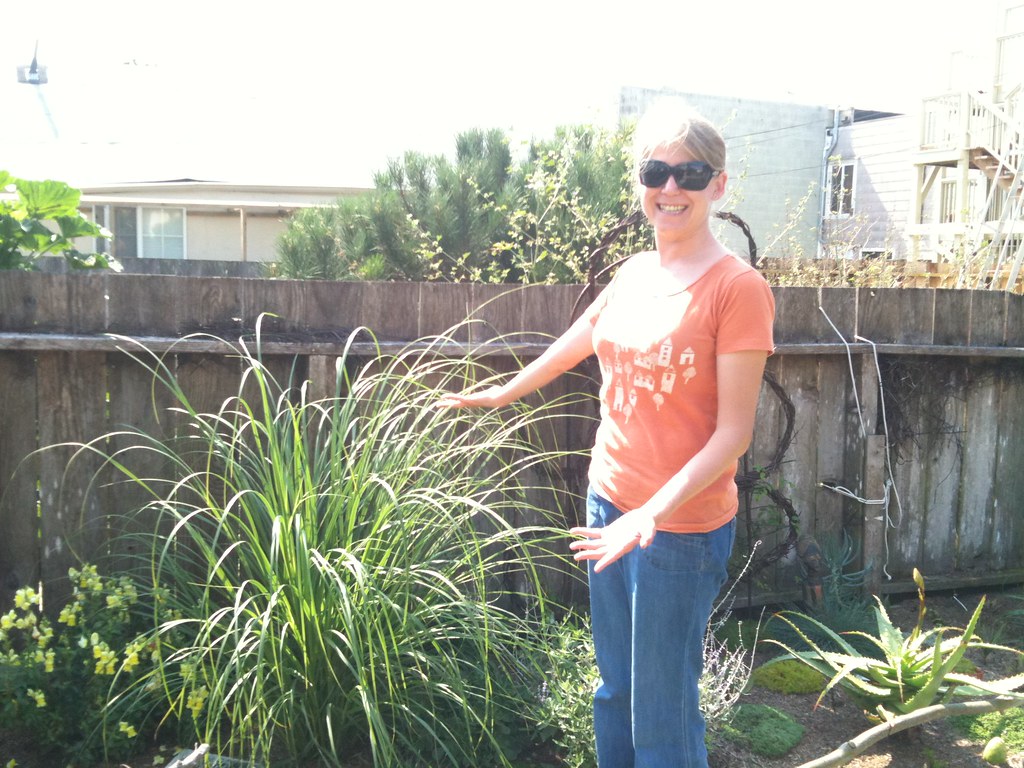
FOR SHAME!!!! What the living f*ck was I thinking? I look so proud in front of it with those terrible sunglasses on. This was way back before we took plant ID classes at City College and one of our worst f*ck ups ever. Back then we thought all the plants growing along the highways in coastal California were beautiful natives. Turns out most of them are not including pampas grass. What’s even worse is that I ordered the pampas grass online when there were plenty of good nurseries that didn’t sell invasive weeds I could have gone to in person. I could have even searched for them online when I was searching for this terrible grass, but I didn’t. At least we eventually learned. It may also be why I developed a decorative grass phobia.

Here is the history of this choker outer of native plants from the California Department of Fish and Wildlife:
Invasive to Avoid: Pampas Grass
(Cortaderia selloana or Cortaderia jubata)
“Pampas grass is a quickly growing grass that forms massive clumps along roadsides, steep cliffs, river banks, and open areas that have been disturbed by human activities or natural disturbances. Introduced to Santa Barbara, California in 1848 by nursery operators, pampas grass has spread all over the state, threatening native plants and the animals that rely on them.
An individual pampas grass stand can produce millions of seeds annually that travel several miles, and because these grasses are very tolerant of intense sunlight, drought, and frost, they are very efficient at establishing in many habitat types. Due to the fact that pampas grass can live over a decade, it has become a favorable plant for people to grow in their gardens.
Invasive plants such as pampas grass displace native plants and create habitats that are lower in biodiversity. Furthermore, pampas grass has leaf blades that are highly undesirable as food or shelter to birds and other wildlife, and can actually cause physical harm to those animals, including humans, because the leaves are extremely sharp. Therefore, it is important that we do our part by not planting pampas grass in our gardens, but instead plant native plants that are comparably beautiful and provide the same utility.”

Man there are a bunch of bad choices in this picture Matti pieced together from old pictures. You can click on it to go to the bigger version and see all our poor choices up close and personal. It’s so embarrassing. That spiney bro was free and terrible. Look at the baby tears. I’d be pulling that crap out for years. The Fuchsia thymifolia on the far right was the only thing that didn’t get yanked along with the California pipevine behind it. Ripping out the pampas was a bitch as it’s Latin name Cortaderia (cut-the-crap-out-of-your-hands) implies. Our shame spiral was too deep to even think about taking pictures of digging the beast out.

At least it improved a little the next year. My fuchsia obsession started early on in California, I don’t even remember growing that little ballerina one tucked in. It’s weird to have grown so much stuff in so many different places you actually forget you grew it until you see pictures again. Gophers were regularly taking stuff out at the beach garden.

This is two years later on the same side of the yard. I loved that California pipevine in the fuchsia sandwich so much. It took a couple years for it to get going, but it was so much fun.
If you live in California and are worried about planting noxious weeds or unknowingly harboring plants from the dark side there’s a great website that tells you what to look out for called Plant Right. They’re down to only seven plants you may still see in nurseries and pampas grass is still one of them. That nasty ass myoporum tree I complained about in last week’s f*ck up dropping leaves in the Agave is on the retired list of gross things you should rip out if you have them. The watch list is also something you may want to take a look at, as many of those plants are still found in nurseries, but you’ll also see them partying like rock stars on the sides of the roads. There’s no need to plant invaders when there are so many amazing natives and respectful visitor plants to choose from here. California Native Plant Society has this amazing directory of native plant nurseries all over the state, too.

3 thoughts on “Friday Garden F*ck Ups: Pampas Grass”